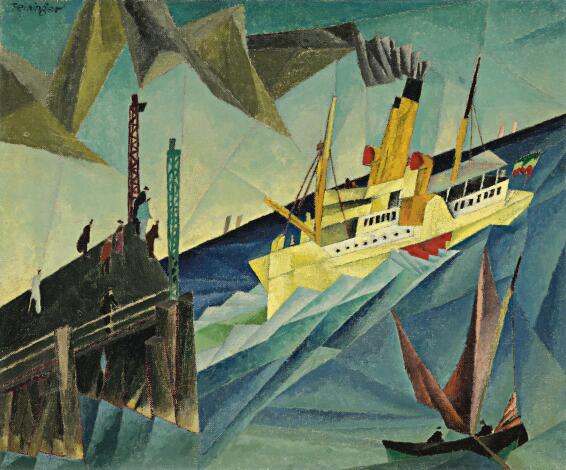- 3
Lyonel Feininger
Description
- Lyonel Feininger
- RADDAMPFER AM LANDUNGSSTEG (SIDE-WHEEL STEAMER AT THE LANDING)
- signed Feininger (upper left); signed Feininger and dated 1912 on the reverse
- oil on canvas
- 40 by 48cm.
- 15 3/4 by 18 7/8 in.
Provenance
Kunsthandel Jacques Goudstikker NV, Amsterdam (on consignment from the above, by October 1933 and until at least December 1940)
Re-purchased by Kunsthandel Jacques Goudstikker NV from the administrators of the Aryanised dealership of Kunshandel voorheen J. Goudstikker NV, 9th June 1949 (their auction: Mak van Waay, Amsterdam, 4th October 1949, lot 216)
Mrs Meta Legat (née Ehrlich), Dreibergen & New York (purchased at the above sale for NGL 200)
Fritz Katz, New York (acquired from the above in 1972)
Thence by descent
Exhibited
New Orleans, Museum of Art, German and Austrian Expressionism, 1975-76, no. 12
Chicago, Museum of Contemporary Art, Art in a Turbulent Era, 1978, illustrated in the catalogue
Literature
Robert Hughes, 'Art: The Anguish of the Northerners', in Time, New York, 27th March 1978, illustrated
Lyonel Feininger: Erlebnis und Vision die Reisen an die Ostsee 1892-1935 (exhibition catalogue), Museum Ostdeutsche Galerie, Regensburg & Kunsthalle, Bremen, 1992, illustrated p. 193
Achim Moeller of The Lyonel Feininger Project LLC has confirmed the authenticity of this work, under certificate number 424-01-05-11. The work will be included in volume one of his Catalogue Raisonné of Paintings.
This work is offered for sale in cooperation with the heir of Hugo Simon.
Condition
"In response to your inquiry, we are pleased to provide you with a general report of the condition of the property described above. Since we are not professional conservators or restorers, we urge you to consult with a restorer or conservator of your choice who will be better able to provide a detailed, professional report. Prospective buyers should inspect each lot to satisfy themselves as to condition and must understand that any statement made by Sotheby's is merely a subjective, qualified opinion. Prospective buyers should also refer to any Important Notices regarding this sale, which are printed in the Sale Catalogue.
NOTWITHSTANDING THIS REPORT OR ANY DISCUSSIONS CONCERNING A LOT, ALL LOTS ARE OFFERED AND SOLD AS IS" IN ACCORDANCE WITH THE CONDITIONS OF BUSINESS PRINTED IN THE SALE CATALOGUE."
Catalogue Note
Raddampfer am Landungssteg exemplifies Feininger's perspectival inventiveness at the height of his involvement with the German Expressionist group Die Brücke in 1912. The scene depicts a paddle steamer as it leaves the pier at Heringsdorf, a fashionable seaside resort on the Baltic island of Usedom. It was there during the summer of 1912 that Feininger refined his artistic style, devising innovative pictorial representations of the natural world. Feininger's new approach referenced the aesthetic of French Cubism, which had taken hold of the avant-garde across Europe, but applied his reshuffling of space to grander subjects in an attempt to synthesise the rhythms, forms, perspectives and colours of his surrounding environment.
Feininger explained the stylisation of this painting and others he did that year in the following terms: '1912 I worked entirely independently, striving to wrest the secrets of atmospheric perspective and light and shade gradation, likewise rhythm and balance between various objects, from Nature. My "cubism", to so miscall it, for it is the reverse of the French cubists' aims, is based upon the principle of monumentality, concentration to the absolutest extreme possible, of my visions... My pictures are ever nearing closer the Synthesis of the fugee... My "cubism" (again, falsely so-called); call it rather, if it must have a name, "prism-ism"' (quoted in H. Hess, op. cit., p. 56).
Between 1908 and 1913, Feininger visited Heringsdorf every summer, making excursions along the Pomeranian coastline. This maritime province of beaches, fishing ports and old Hanseatic villages provided Feiningner with a rich vein of subject-matter. His sketchbooks are filled with studies of sailing boats and imaginary galleons plying the inland seas, and also capture the distinctive atmospheric effects of the Baltic shores. In the present painting, Feininger depicts a contemporary scene that would have been instantly recognisable to the fashionable crowds from Berlin that gathered in Heringsdorf each summer. It shows the paddle steamer Freia pulling astern of the famous Kaiser-Wilhelm-Brucke, one of the largest and most elaborate piers in continental Europe at that time, with sailing boats on the horizon and in the foreground. Feininger returned to this subject in 1917 with his oil painting Odin I. Leviathan, depicting another of the Stettin-registered steamships that catered to the strong seasonal demand for coastal excursions along the Baltic.
Fig. 1, A postcard of the side-wheel steamer 'Freia' at Heringsdorf, 1911

